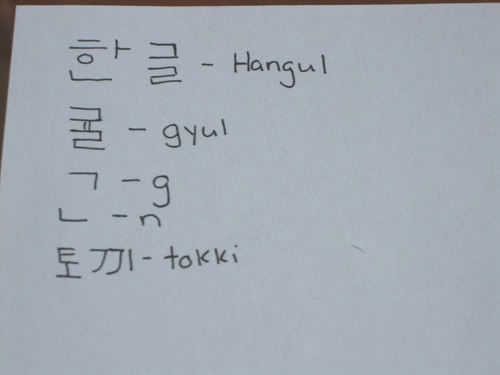Every few days I open it up and start studying, but I get overwhelmed quickly and start to forget what I've learned, especially with the vowels, of which there are twenty one. So I'm changing tactics. Instead of just trying to learn the letters, I'm going to try and learn a new Korean word each day. The idea is that I'll have a better chance remembering what sound goes with what letter if I can associate it with a word. Each word will have at least one new letter in it, so by the end of the month, I should know the alphabet, plus at least thirty new Korean words. Since this will basically double my vocabulary, it's a win-win situation.
Today's Korean word is 귤 (gyul). It means either tangerine or orange. The fruit itself looks more like a tangerine and is seedless like a clementine, but my book gives the definition as orange. It taste sweet, a little tart and absolutely amazing. I've eaten approximately 53890403 귤 (gyul) in the past two months and I've bought none of them. I'm not a huge fan of Korean food and 귤 (gyul) is one of the few foods people at my school know I like, so it's severed at every school event. Every time there's 귤 (gyul) at lunch, I'm always given the left overs and one time during a volleyball tournament at another school, my co-teachers made me stuff my bag with 귤 (gyul) from the reception before I was allowed to leave. It's an especially good word to know since a) I'll actually use it and b) it contains the letter g. In Hangul, the letter 'g' looks like this 'ㄱ'. The letter 'n' looks like this like this 'ㄴ' and I've had the hardest time remembering which one is which.
In addition to 귤, I also learned the word 토끼 (tokki), which means rabbit. One of my students taught me the word before class today. She was wearing a hoodie with a monkey on it and when she came into the classroom, she pointed to her chest and said, "Monkey!" I told her very good and then said monkey in Korean. Her eyes got very big and she said, "Very good, teacher!" Then she pantomimed rabbit (held up two fingers to be the ears and made them hop) and told me "Tokki." I repeated the word a couple of times until I said it to her satisfaction and we grinned at each other. And then there was this explosion of English. She told me her favorite animal (monkey), favorite color (red) and all about her family. I could have hugged her. This was one of the few times I've seen a student go beyond the basic formulaic statements we teach in class, make a cognitive leap about the different words and phrases they've been taught and actually communicate in English. I'm so proud of her!
Bonus picture: I know not everyone's computers display the Korean alphabet, here's a picture of all the Korean in this entry:


No comments:
Post a Comment